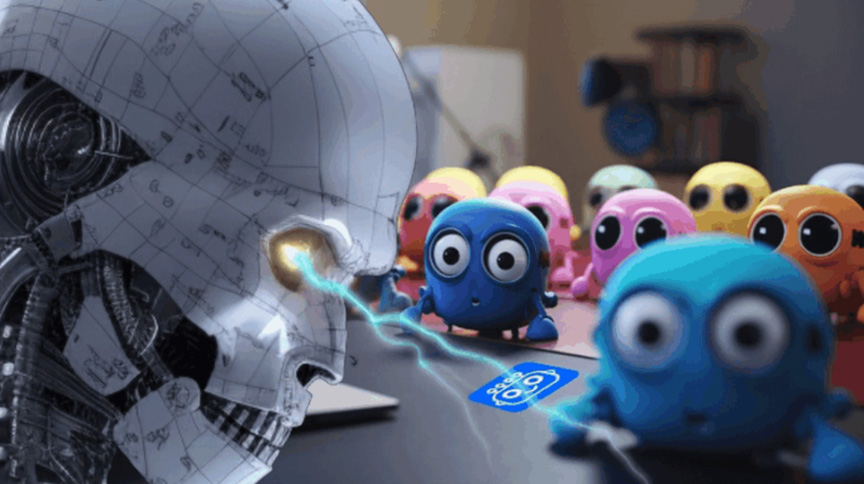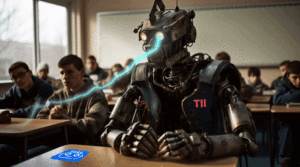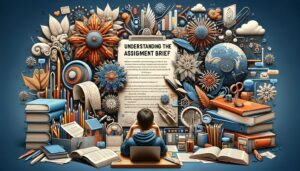“Does Turnitin detect AI writing?” Ah, the burning question in many a student’s mind these days!
As we see artificial intelligence (AI) generated text skyrocket in the academic world, we all wanna know if platforms like Turnitin are up to sniffing out this AI-crafted stuff.
Makes you ponder on the whole AI writing gig, doesn’t it? Is it worth the risk if you get caught? How reliable are these Ai detection tools to begin with?

Try these new AI-powered tools:
- 5 Best AI Detectors To Unmask AI-Written Content With Accuracy
- 5 Best AI Writers To Boost Your Productivity And Content Quality.
- This "Secret AI Writer" Can Bypass AI Detection Like A Pro.
Hold your horses, I’ve done a good deal of digging to see how spot-on this detection stuff is.
In this article, we’re gonna chat about whether Turnitin can catch AI writing, how good it is at sniffing out plagiarism, how it affects teachers and students, and what we can do to keep academic honesty alive and well in this AI-dominated era.
Let’s dive in and answer all those queries! Keep reading to find out if Turnitin is a match for AI-penned work!
Article At-A-Glance
-
- Turnitin’s AI-based detective tool is pretty good – it spots texts made by ChatGPT and GPT3 with a 97% accuracy rate. But when it comes to newer, more complex AI stuff, it might trip up a bit.
- Turnitin offers teachers the choice to use its AI writing detector, which is great at catching potential plagiarism and machine-made stuff. This beefs up the honesty factor in schools.
- But as AI tech gets better and better, it’s getting trickier to tell the difference between what’s human-made and what’s churned out by a machine.
- There are some serious questions about privacy when using these AI detection tools. It’s crucial to think about data privacy, get people’s consent, and stick to the rules to protect students’ rights and keep everything on the legal side of things.
Table Of Contents
Does Turnitin Detect AI Writing?
Turnitin has an AI writing detection feature that can tell when text has been whipped up by AI. It looks for any odd bits of text or phrases that might mean generative AI tools like ChatGPT, GPT3, and other language-generating algorithms have been used.
It counts the number of sentences that look like they might have been written by a computer and gives teachers the heads up if it finds something fishy.
By analyzing sentence structures, language use, and context clues, it spots potential plagiarism. Always learning and being updated with diverse data, Turnitin’s AI gives teachers a handy tool to keep academic integrity strong and original work valued.
The AI Writing Sniffer And Its Report Card
Like I mentioned earlier, Turnitin’s rolled out this AI writing detector that’s trained to spot 97% of the stuff created by ChatGPT and GPT3.
It’s their way of tackling the issue of AI-aided writing tech, which is muddying the waters between human and machine-made text.
This AI detection tool shows users a percentage, telling them how likely a chunk of the text has been penned by a computer.
This AI detection tool shows users a percentage, telling them how likely a chunk of the text has been penned by a computer.
This gives teachers a quick way to see just how much AI writing is in a student’s work or any other documents.
On top of that, Turnitin’s AI writing report points out the exact bits of a document that have been written by AI, and it even clues you in on details like which exact words were whipped up by an AI tool, sentence structures, patterns, grammar slip-ups, and any odd usage of keywords.
These are all signs that might mean automated scripts were used to make the content.
False Positives: When the Detector Gets It Wrong
When it comes to human text getting flagged as bot-written, we call those false positives. Now, it does happen, which is why it’s important to get the 411 on these AI detection gizmos.
To dodge this curveball, Turnitin is hell-bent on keeping the false positive rates for documents below 1%. When it comes to sentences, about 4% of bot-penned texts are mistaken as human-written.
Then, there’s the AI Writing Preview. The data shows it’s been schooled on academic writing and can spot 97% of texts written by our artificial pals, with only 1 in 100 writings being wrongly pegged as machine-made.
And check this out: they ran this massive 800k pre-Global Pattern Analysis (GPA) that suggests hefty documents, with more than 20% of their content being AI crafted, see a lower mistake rate with only 0.5% of them getting the false flag.
Getting A Handle On Turnitin’s AI Writing Spotting Power
Turnitin uses algorithms to look for patterns and similarities in text to work out if it’s been churned out by AI. It can pick up on paraphrasing, rewording, and even sneaky text manipulation to dodge detection.
It checks out sentence structures, how language is used, and looks for clues in the context to spot possible plagiarism.
Plus, Turnitin’s AI is always being updated and trained on a huge and varied dataset to keep getting better and stay one step ahead of the sly techniques students might use to trick the system.
Is Turnitin’s AI Writing Detector Up to Snuff?
The whole point of Turnitin’s AI detection system is to point out potential copycats and bot-written pieces. But, let’s be real, how effective is it at actually doing what it says on the tin?
Putting The Detection Tool To The Test
Here’s a good starting point: take your human scribbled and AI written essays, run ’em separately through this AI sniffer, and see how it fares for each. Kinda like a face-off between Team Human and Team Bot, if you will.
Now, don’t just stop at one test. You’ve gotta put it through the wringer.
Throw a heap of different tests at it, crank up the difficulty level for both sides, and see what bubbles up. Any false positives or sizeable gaps compared to what Turnitin is shouting from the rooftops? That’s the kind of data you’re looking for.
Hitting The Bumps In The Road Of Spotting AI Writing
Let’s face it, sniffing out AI-penned writing is no walk in the park, and Turnitin is up against some real challenges here. AI tech is moving at the speed of light and the ability for AI to fake it as a human scribe is only getting more convincing.
This means that services like Turnitin have a tough time spotting AI-penned pieces, particularly because they’re often designed to pick up on odd writing styles or phrases, which might not pop up in AI-written content.
Plus, we’ve got the problem of false positives when spotting bot-created content, mostly because the software struggles to pick up on the tiny differences between the real deal and computer-spun text.
Plus, we’ve got the problem of false positives when spotting bot-created content, mostly because the software struggles to pick up on the tiny differences between the real deal and computer-spun text.
These challenges could have a big impact on how accurately plagiarism is spotted because educators might miss plagiarised pieces, thinking they’ve been penned by an AI rather than swiped from another source.
What This Means for Catching and Stopping Plagiarism
Turnitin’s nifty knack for catching AI writing is on its way to becoming a hot commodity for teachers and schools out to uphold academic honesty.
They’ve got a fresh way of sniffing out plagiarism in content whipped up by AI tools, think ChatGPT. What a time saver this could be for teachers trying to spot and stamp out cheating in class or in an online course.
Sure, Turnitin’s got some blind spots when it comes to sniffing out AI-created stuff. But hey, we’re all not perfect, right? If AI throws them a curveball, they need to figure that out pronto so teachers can trust they’re using the right tool to fight plagiarism and find AI-generated content.
To spot a piece as AI-written, you’re going to need some extra know-how to pick out text patterns tied to different software. This just goes to show how important it is to have a deep understanding and specialized skill to accurately flag content created by AI.
Dealing With False Positives And Making The Detection Better
To make sure they’ve got their detection game on point, Turnitin has put a few cool moves into play to shave down those pesky false alarms.
First off, they’ve rolled out this new indicator that throws up a star sign whenever their tech sniffs out less than 20% AI word wizardry in student work.
This nifty feature gives schools and students a head start to dig a little deeper before jumping to conclusions that a paper might’ve been churned out by a smarty-pants AI.
Turnitin’s AI Writing Detector In The Education World
Teachers and schools are leaning more and more on Turnitin’s AI writing detection system. It’s got the knack for giving detailed feedback to help spot potential copycats in a snap.
With an AI writing detection system like Turnitin that can pinpoint and take care of potential plagiarism and machine-created content, teachers and schools can avoid bumps down the road.
The Effect on Teachers and Schools
Being able to spot work not written by humans can be a massive boon for teachers and schools needing to check the authenticity of student work.
With a helping hand from Turnitin, teachers can be sure that essays, reports, and theses are all human-crafted.
Turnitin can help equip school heads with the tools they need to tackle potential cases of academic dishonesty involving AI tech.
Even though there might be some innocent students flagged with a high AI score on their papers because of a glitch in the system, Turnitin can help equip school heads with the tools they need to tackle potential cases of academic dishonesty involving AI tech.
Crossing The T’s And Dotting The I’s On Privacy And Consent
Using AI tech in education means we’ve got to think about data privacy and making sure everyone knows what’s going on. Turnitin’s AI writing detection tool brings these concerns into sharp relief.
Using the tool means getting access to student work samples, which can raise some legal eyebrows about when and how students should be looped in and what rights they might have about their data.
This also means teachers have to make sure they’re getting the go-ahead before running scans.
Data privacy and student consent laws can be a mixed bag, with different levels of protection for student rights about online activities or studies in different educational settings.
So, schools need to come up with a way to stick to rules like the GDPR or COPPA, depending on where they’re based.
Keeping It Real in the AI Writing Era
With the rise and rise of AI-spun text, it’s a no-brainer that schools and universities need to jump on the bandwagon, tackling ethical conundrums head-on and spouting clear guidance about keeping it real in this high-tech era.
By roping in an AI writing detection system, learning hotspots can keep the flag of originality and honesty flying high, while also gearing up students to face off with the curveballs thrown by these emerging tech.
Schools Giving AI Tech the Cold Shoulder
Even though they could bring in an AI writing detection system, schools around the world have had a reaction to the worry over plagiarism caused by AI tech like ChatGPT, GPT-3, and OpenAI’s Generative Pre-trained Transformer (GPT).
Back in 2019, Harvard University made it clear that “the use of machine learning or AI-generated writing is considered a form of plagiarism.”
Since then, students all over the place have come up against similar hurdles when it comes to using AI in their work.
Schools are worried that tech getting better could blur the line between cheating and genuine research, since it could make it harder for teachers to tell if an essay was actually written by a student or churned out by a computer program.
Schools are worried that tech getting better could blur the line between cheating and genuine research, since it could make it harder for teachers to tell if an essay was actually written by a student or churned out by a computer program.
The privacy side of things is also a bit of a grey area when it comes to these tools, since some programs need users’ personal details, like financial info, to run them.
So, a lot of education systems are now making rules against using AI tools, out of worry that personal data might be misused or even nicked from students.
For example, George Washington University has put in place rules that say any kind of “unfair competition,” which includes handing in essays made by AI programs, is strictly off-limits on campus.
Getting Cozy With AI Tools In Education
Look, there’s no two ways about it. AI technology is changing up the game big time, reshaping how teachers interact with their students and creating educational materials that spark creativity while taking a load off their shoulders.
These smarty-pants computers, armed with deep learning algorithms, can chew through massive amounts of data in no time, creating course content or grading written assignments – jobs that would take humans ages to do because of limited time and tight budgets.
Think about it, AI could whip up lecture slides, interactive quizzes, and even custom study plans tailored to each student’s academic goals.
And get this, natural language processing lets teachers or professors grade written exams lickety-split, giving detailed feedback without sacrificing on accuracy or precision. No more late nights grading stacks of papers one by one.
Plus, AI chatbots can handle some of the admin stuff, like answering students’ questions about grades or class rules when school’s out. More and more, we’re seeing evidence that these benefits can massively boost student engagement throughout their school years.
Cranking Up The Ante on Turnitin’s AI Detection
Turnitin’s AI detection system is no slouch when it comes to rooting out AI-spun writing. But let’s cut the chase, it’s not all sunshine and rainbows.
Accuracy’s a bit of a toss-up and you could land smack dab in the middle of false positives if the fine-tuning goes haywire. Schools and colleges gotta mull over the domino effect of roping in tech like this to keep academic honesty above board, especially now that AI-spun content is popping up everywhere.
AI-detection systems are upping their game by the day, and if we play our cards right with data wrangling, they’re only gonna pack a bigger punch.
AI-detection systems are upping their game by the day, and if we play our cards right with data wrangling, they’re only gonna pack a bigger punch.
But, it’s as clear as day that even though these tools are starting to show some glimmers of hope, we’re gonna need a beefed-up legal safety net as this tech morphs and evolves.
Meet our resident tech wizard, Steve the AI Guy. Now, before you get any wild ideas, let’s clear up one thing – he’s 100% human! I mean, he’s got the work history to prove it. He spent a decade diving into the deep end of the tech industry doing business intelligence work, splashing around with two of the world’s largest business consulting companies, Deloitte and Ernst & Young. Learn More










